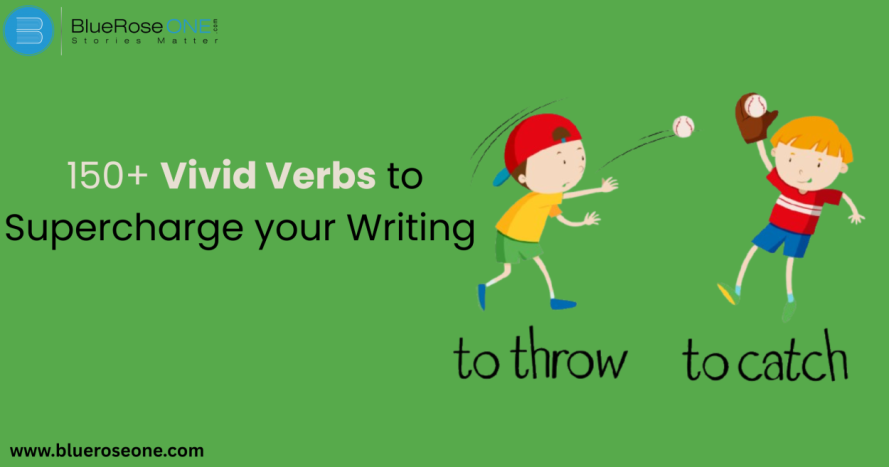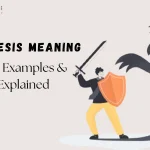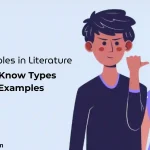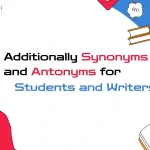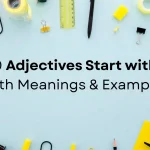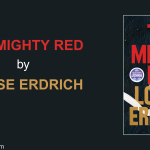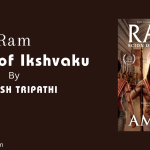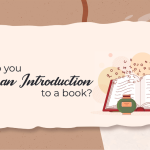What Are Vivid Verbs?
Vivid verbs are dynamic, descriptive verbs that pack a punch. Instead of saying “walked,” you might say “strode,” “marched,” or “stumbled.” They don’t just tell you what happened, they show you how it happened.
They breathe life into otherwise flat writing, painting a clearer and more exciting picture for your reader.
Why Use Vivid Verbs in Writing?
Vivid Verbs vs. Weak Verbs
Vivid verbs are precise, dynamic action words that evoke clear, engaging imagery in the reader’s mind such as sprinted, whispered, or grumbled.
In contrast, weak verbs such as go, say, and do are generic and frequently require adjectives or additional information to express the same meaning. Using vivid verbs not only enriches your writing style, but also makes your sentences more compact, lively, and emotionally resonant, allowing readers to better imagine the action.
Weak verbs are generic and don’t give the reader much information. Words like “went,” “did,” or “got” lack flavor.
Compare:
- He went to the store.
- He dashed to the store.
The second sentence shows urgency. That’s the vivid verb magic.
You may also read: Antithesis Meaning: Definition, Examples & Usage Explained
How They Improve Clarity and Impact
Vivid verbs improve clarity by replacing ambiguous or generic phrases with specific, action-driven language that immediately conveys meaning.
Instead of telling readers what is going on, vivid verbs demonstrate it, eliminating the need for unnecessary adverbs or explanations. This improves the writing’s clarity, engagement, and visual appeal.
For example, saying “he sprinted” rather than “he ran quickly” creates a more powerful image and emotional impact, helping the reader to connect more intimately with the scenario or character.
How to Identify and Replace Weak Verbs
Common Weak Verbs to Watch Out For
- Go
- Do
- Get
- Make
- Have
- Be (is, was, are, etc.)
These are red flags that a more powerful verb could be used.
Step-by-Step: Replacing Weak Verbs in a Sentence
- Find the verb.
- Ask yourself: How did the action happen?
- Replace with a more precise or visual alternative.
- Read aloud to see if it flows naturally.
Example:
Weak: She made a cake.
Stronger: She whipped up a cake.
Quick Verb Upgrade Checklist
- Is this verb generic?
- Can the verb paint a clearer picture?
- Can I remove an adverb if I upgrade the verb?
You may also like: Tone vs Mood Explained: What’s the Real Difference?
Categories of Vivid Verbs (With Examples)
Vivid Verbs for Action Scenes
- Slammed
- Lunged
- Hurled
- Gripped
- Tackled
Vivid Verbs for Dialogue Tags
- Whispered
- Snapped
- Murmured
- Barked
- Gushed
Vivid Verbs for Emotions
- Trembled
- Shuddered
- Gloated
- Beamed
- Sulked
You may also like: Tone Examples in Literature: 15 Must-Know Types With Examples
Vivid Verbs for Movement
- Slinked
- Darted
- Staggered
- Strolled
- Hobbled
Vivid Verbs for Senses
- Gawked
- Sniffed
- Crunched
- Sizzled
- Murmured
Vivid Verbs for Destruction and Conflict
- Crushed
- Smashed
- Blasted
- Shredded
- Collapsed
You may also like: Additionally Synonyms and Antonyms for Students & Writers
Vivid Verbs for Creation and Building
- Sculpted
- Forged
- Composed
- Assembled
- Crafted
150+ Vivid Verbs List (Grouped by Use Case)
25 Verbs to Show Strong Emotions
- Fumed
- Raged
- Wept
- Laughed
- Shivered
- Smirked
- Pouted
- Sighed
- Yelled
- Chuckled
- Snorted
- Sulked
- Grinned
- Sneered
- Glowered
- Beamed
- Gasped
- Cringed
- Shuddered
- Trembled
- Muttered
- Stammered
- Gloated
- Ranted
- Sobbed
25 Verbs for Physical Action
- Slammed
- Gripped
- Struck
- Snatched
- Tossed
- Yanked
- Squeezed
- Pounded
- Knocked
- Pushed
- Pulled
- Lifted
- Shoved
- Punched
- Twisted
- Scraped
- Dragged
- Hauled
- Slammed
- Flung
- Bashed
- Swung
- Tripped
- Skidded
- Ripped
You may also read: Realistic Fiction: Definition, Key Elements and Examples
25 Verbs for Character Movement
- Sprinted
- Staggered
- Tiptoed
- Crept
- Strode
- Darted
- Hopped
- Crawled
- Scampered
- Dashed
- Marched
- Slid
- Lurched
- Wandered
- Paraded
- Raced
- Fled
- Hobbled
- Skipped
- Roamed
- Bolted
- Stormed
- Glided
- Trotted
Rushed
25 Verbs for Speaking and Tone
- Shouted
- Whispered
- Stammered
- Snapped
- Barked
- Drawled
- Rambled
- Murmured
- Screeched
- Boomed
- Croaked
- Giggled
- Hissed
- Replied
- Grumbled
- Mumbled
- Quipped
- Blurted
- Argued
- Inquired
- Roared
- Interjected
- Ranted
- Groaned
- Mocked
You may also like: Throne of Glass Series in Order: The Right Order to Read
25 Verbs for Senses (See, Hear, Smell, Taste, Touch)
- Sniffed
- Licked
- Tasted
- Touched
- Rubbed
- Nibbled
- Glimpsed
- Spied
- Glared
- Peered
- Gazed
- Listened
- Overheard
- Caught (a sound)
- Savored
- Sampled
- Prodded
- Brushed
- Slid
- Grated
- Echoed
- Clinked
- Popped
- Sizzled
Crackled
25 Verbs for Writing About Nature or Setting
- Rustled
- Whispered
- Blazed
- Drifted
- Bloomed
- Withered
- Shimmered
- Flowed
- Soared
- Plunged
- Erupted
- Towered
- Rippled
- Sparkled
- Howled
- Roared
- Surged
- Tumbled
- Beamed
- Slithered
- Hovered
- Faded
- Crashed
- Fluttered
- Chimed
You may also like: 150 Useful Tone Words to Describe Tone | Explanation with Examples
Vivid Verbs in Action: Before vs. After Examples
Weak vs. Strong Verb Sentences
- Weak: She walked into the room.
- Vivid: She glided into the room.
- Weak: He ate his food quickly.
- Vivid: He devoured his food.
Transforming a Paragraph with Vivid Verbs
Before:
She went to the kitchen. She got a plate and put food on it. Then she walked back and sat down.
After:
She strode into the kitchen, grabbed a plate, and piled it with food. Then she marched back and plopped into her chair.
Tips for Using Vivid Verbs Without Overdoing It
Avoiding Purple Prose
Vivid verbs can add energy to your writing, but using them excessively can result in purple prose, which is language that is overly dramatic or elaborate.
Instead of keeping readers interested, this style diverts them by emphasising vocabulary display over clarity. Put tone and accuracy above flair to avoid this. Consider whether the verb emphasises itself or adds meaning.
For instance, think about your audience and intent before saying “she walked” rather than “she pirouetted gracefully across the room.” Finding the ideal balance between making your text vibrant, strong, and suitably expressive and preserving readability is crucial.
Balancing Simplicity and Impact
While vivid verbs can energise your writing, employing them excessively may overwhelm readers or make your prose sound forced.
The idea is to strike a balance between simplicity and impact use vivid verbs that boost clarity and emotion without seeming artificial. For example, replacing “walked” with “strode” adds purpose, whereas using “gallivanted” in a serious context may feel jarring.
Strong verbs should correspond to the tone, audience, and goal of your writing. In narrative or descriptive writing, a single vivid verb can replace three adjectives. Allow vivid verbs to enhance your writing rather than detract from it. To keep readers engaged, aim for precision rather than ornamentation.
You may also like: 100 Words to Describe Music: From Classical to Rock and Beyond
Editing for Verb Variety
When using vivid verbs to improve your writing, it’s important to keep your sentences interesting and natural. Repetition of similar verbs, especially powerful ones, can reduce their effect and make your writing appear forced.
During the editing process, check your work for overused verbs and replace them with alternatives that better fit the tone and context. Use a thesaurus intelligently, and make sure each substitution flows seamlessly into the sentence structure.
Strive for balance by pairing strong action verbs with delicate moments to generate rhythm. Editing for verb variety not only sharpens your prose, but it also broadens the reader’s experience without overwhelming them.
Tools & Resources to Help You Use Vivid Verbs
Thesaurus Recommendations
- Power Thesaurus
- Merriam-Webster
- WordHippo
Chrome Extensions & Writing Tools
- Grammarly (Pro version suggests word upgrades)
- ProWritingAid (Great for verb variety)
- Hemingway App (Highlights weak verbs)
Conclusion
Vivid verbs are the unsung heroes of great writing. They take your words from dull to dynamic and turn passive prose into powerful storytelling.
Whether you’re writing fiction, a blog, or just a killer social media caption, vivid verbs are your secret weapon. So next time you’re about to “go” somewhere in your writing, try dashing, strolling, or sprinting instead.

